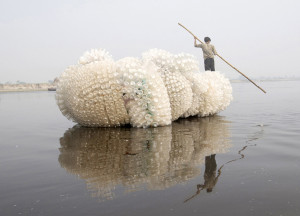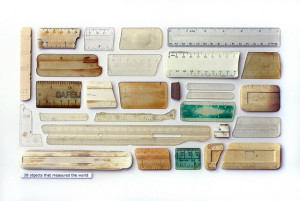The weather may be catastrophically portentous in Los Angeles; but, absent a 9 or 10 Richter scale earthquake or a tsunami that drags Santa Monica out into the Pacific, the show must go on (hey this used to be Hollywood). You may or may not be going out to see and hear it, but it will be there waiting for you (until curtain, or for a few weeks anyway). Fortunately in the best instances, this can be about something more than just moving the scenery; it can be about moving the conversation. Although in theory you could do that with a book (or your screens, music, etc.) – assuming your abode is air-conditioned and you’re not camping out at a bar or cineplex – it’s more than likely at some point that you’re going to be caught out in broad, brutal daylight and away from your neighborhood, if only commuting to and from your workplace. Bearing in mind that museums are air-conditioned, you might escape the blazing sunlight and take refuge in these serene spaces – with the caveat that the conversations engendered in their galleries may carry you both physically and intellectually into slightly disturbing regions. (What’s to worry about? At least you’re not risking heatstroke.)
Wouldn’t you know that there are some must-see shows up (or about to open) in this killing heat? It’s a bit like something the artist, Frances Stark said at a press preview of her own show at the Hammer (another must-see I’ll chat about in another post): “I know there’s a lot of stuff here…. And there’s a ton more.” You could get that feeling within the space of a couple blocks on Wilshire Boulevard between Fairfax and La Brea, where two fantastic shows opened recently right across the street from each other. It almost goes without saying that one of them is at LACMA, on BCAM’s second floor. The other (bearing more than a trace of LACMA DNA) is at the Craft and Folk Art Museum, which over the last few years has come into its own as not-to-be-missed destination on the art world’s itinerary. (For those who (like myself) couldn’t get enough of Chris Francis’s exhibition of sculptural shoes, you’ll be happy to know that his couture-cobbling residency continues in the front of the museum – with fresh additions to the inventory weekly.)
What the two have in common is a specific bearing on our relations to materials in the most basic, elemental sense – our apprehension, perception, attitude and approach to them; and the way they bear on our larger view of the worlds around us – both the physical environment and culture and society. The CAFAM show (consistent with its program and emphasis) addresses that material with tactile directness and specificity. It’s organized around the work of fifteen contemporary artists who work principally (though not exclusively) with paper, not simply as two-dimensional surface or support, but as an infinitely flexible, mutable, heterodox and multi-dimensional material; to be cut, stenciled, molded, sculpted, fused or integrated with other media or materials, and blown out into self-contained installations or environments, or abstracted or reduced (as in one instance here) virtually to ashes.
If you’re looking for the drama in art (or design or fashion), it’s never a bad idea to start with the cut or the tear (coupure preceding couture); and that was more or less Howard Fox’s starting point in curating the show – first singling out Francesca Gabbiani and Tm Gratkowski, a powerful starting point. (Gabbiani’s chromatic genius and gorgeously wrought work have always haunted me; and I think of some of the Gratkowski works I’ve seen almost as radioactive time capsules.) As with any collision amongst radioactive particles, you soon end up with a powerful chain reaction. Moving towards a bigger bang, Fox brought in Chris Oatey and Lorenzo Hurtado Segovia; and soon enough there were fifteen, including Soo Kim, Minoru Ohira, Enrique Castrejon, Chris Natrop, Echiko Ohira, Margaret Griffith, Susan Sironi, Tam Van Tran, Lecia Dole-Recio, Rebecca Niederlander, and (finally, delightfully!) Phranc. The show’s title, Paperworks, is almost too modest, encompassing as it does the most cerebral abstraction and the most expansively environmental and surreal domains.
The sense of material heterodoxy extends to the installation itself, which ebbs and flows loosely without too many sharp turns, following the Museum’s open and strikingly corner-less floor plan. Oatey’s carbon paper clouds billow over and past Sironi’s cut (shredded and minced) paper nature morte and Castrejon’s quasi-mathematical viral clusters eddying us past (or through) Hurtado-Segovia’s double-sided ‘tapestry walls’ of woven paper, and toward an actual three-walled space where Chris Natrop’s elaborate installation of paper foliage, sound-and-light and rear video projection make a soft and surreal night jungle of the space. And that’s just one quadrant of the exhibition. I’ll have to leave further discussion of the show for another post; but credit that modesty – which in this instance really means elegance, rigor and imagination – to the fabulous Mr. Fox.
In the meantime, half-way across town, at the USC Fisher Museum of Art, the signature material of the Anthropocene (and possibly its coffin nail) is the focus of Gyre: The Plastic Ocean – the continent-scale (and ever widening) disaster that plastic is creating in all the world’s oceans, but perhaps most dramatically in the south Pacific. Among the 25 artists included in this international show from Finland to Australia, are a significant number from Alaska, which may have something to do with the fact that the show was organized by the Anchorage Museum and curated by Julie Decker, its Director. Given the long-standing fierce battles to preserve the Arctic National Wildlife Refuge, on-going disputes regarding North Slope drilling, the dogged attempts by BP and Royal Dutch Shell to drill in the Beaufort Sea, and ExxonMobil’s on-going campaign of public deception regarding climate change (see, the Los Angeles Times’ front-page coverage in the Sunday edition, first reported by InsideClimate News, with follow-up in both The New Yorker, and a segment of WNYC’s media-watch show, On the Media), the show could not be more timely.
The show has an archaeological feel – it could as easily be mounted in a science or natural history museum. It’s as if we’re confronting the ruins of Western civilization in both macro- and microcosm. There are works in every medium – but plastic dominates materially, not simply in terms of its relationship to the craft or medium, or even by virtue of the show’s theme, but simply because it is naturally the stuff of an artist’s everyday bricolage; it is a material everywhere at-hand. The show gives overwhelming testimony of the extent to which plastic (and petrochemicals and petroleum-derived materials) permeate our daily lives. Humans have extracted, cracked and processed the fossilized remains of the Jurassic age to create a future Jurassic that will be the last (albeit drawn-out) gasp of the Anthropocene. Painful ironies abound; but contemplating the thousands of years that will pass before some of these durable, permanent-looking materials biodegrade (and their concurrent discharge of secondary toxins in the process) sets the mind reeling.
Many of us are familiar with Edward Burtynsky’s eloquent photo-documentation of the systematic human ruination of the earth’s surfaces – represented here in a digital photograph of a Chinese recycling operation. But a number of artists bring us closer to the everyday damage of our consumer lives. Some of the most poignant works concern our impact on animal lives in the human-devastated wild, especially birds and ocean life. Susan Middleton’s photograph of a northern Hawaiian plover, starved to death because of a red plastic ring clamped to its beak is heart-rending. There are, not surprisingly, a number of works that can be categorized as ‘inventories.’ Steve McPherson is essentially a sculptor and installation artist, but his relatively small works here are touchstones in their documentation of the way materials become simple objects and instruments to be integrated into the machinery of life and culture. “28 Objects that Measured the World” (2010) consists of fragments of rulers, scales and straight-edges – all in plastic, mostly found on an English seashore.
There’s a simplicity, almost a purity, to some of these inventory pieces that goes to the diseased heart of the human condition – the fundamental (and possibly fatal) flaw in our relationship to materials, to objects; to instrumentation and instrumentality; and finally to the physical, natural world and the culture itself. This goes to the heart of the third exhibition in this week-end’s trio of shows – but that will have to wait for the second half of this post. Trust me – it’s worth the wait.
Paperworks runs through January 3, 2016 at the Craft and Folk Art Museum, 5814 Wilshire Blvd., Los Angeles 90036; Gyre: The Plastic Ocean runs through November 21, 2016 at the USC Fisher Museum, 823 Exposition Blvd., Los Angeles 90089





